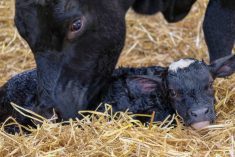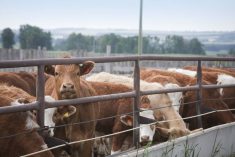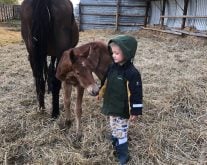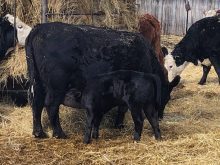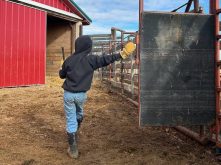Agriculture Canada researchers are not only working to identify where most greenhouse gases (GHG) are produced on Canadian beef and dairy operations, but also the greater challenge of finding economical and practical strategies for reducing emissions.
Because methane from cow-calf operations and dairy farms is the largest contributor to the overall agriculture GHG picture, the goal is to find production practices that reduce GHGs, but still make economic sense.
“One of the issues that’s come along in the last 10 to 20 years has been a concern about GHG emissions coming from livestock agriculture, primarily ruminants,” says Karen Beauchemin, ruminant nutrition research scientist with AAFC’s Lethbridge Research Centre. “I was very interested in identifying the main sources of GHG emissions and looking at what we can change in the way we produce meat and milk.”
Read Also

Harvest wraps up and fall work begins
At the Eppich famly ranch in western Saskatchewan, the fall harvest was successful with few breakdowns, cows and calves have been sorted and a new tractor has arrived
The farm life cycle assessments for greenhouse gas (GHG) emissions from dairy and beef production were made using “Holos” modeling software program developed by AAFC (see sidebar).
Methane emissions
Methane, a potent GHG, is produced in the rumen of cattle as a byproduct of fermentation, especially from a forage-based diet.
Roughly half of all GHG emissions that come from dairy operations are direct methane emissions from milk cows or replacement animals.
“They are necessary emissions associated with digesting feed so that’s a normal process of digestion, which means what we feed the cows is important and anything we can do to reduce the emissions in the digestion process would also have a very big impact on the net GHG emissions associated with producing milk,” says Beauchemin.
Beef cattle are trickier to assess because of the various production stages from cow-calf to backgrounding to feedlot.
“Even when you account for all that life cycle, still over 60 per cent of all the GHG emissions is methane from digestion,” says Beauchemin. “Most of that is from the cow-calf operation and so what we feed cows and growing calves has a big impact on that carbon footprint.”
That turns popular wisdom about beef production on its head. Many consumers have the impression feedlots are producing the most GHG emissions, but that’s not the case, says Beauchemin. “The finishing process is only a very small part of the emissions depending on if it’s a yearling or if it’s a weaned calf. The net amount of GHG emissions coming from the feedlot is roughly 20 or 25 per cent. You can reduce emissions from the feedlot, but it’s not going to have as big an impact as reducing emissions from the cow-calf enterprise.”
Beauchemin says Canada is among the most efficient countries of the world in reducing GHG from traditional beef production.
- From the Canadian Cattlemen: Solid-state digester shows promise
The bigger picture
A team of researchers looked at the life cycle assessment of GHG emissions from the whole farm. There are also emissions from manure in storage or when it is applied to the land, as well as emissions from inorganic N fertilizers. There are also emissions associated with seeding, spraying, harvesting and handling feed and manure.
“The question became where and what do we need to target on the farm to make the biggest impact to lower GHG emissions,” says Beauchemin. “We focused our life cycle from the cradle to the farm gate. We don’t have much influence beyond the farm gate but we wanted to know the amount of GHG emissions produced on the farm to produce a kilogram of meat or a litre of milk.”
How do I benefit?
Most cattle producers would agree that reducing GHG is worthwhile, but would ask, “What’s in it for me?”
Beauchemin says reducing GHG and improving production efficiency can go hand in hand.
“When you calculate the carbon footprint, which is really the GHG emissions per litre of milk or a kilogram of meat, it’s a ratio,” says Beauchemin. “The more product you can get from the system, the lower the carbon footprint… so what we want to do is take the whole farm and look at the production systems and identify the weakest links. Where are the inefficiencies? Those inefficiencies are often costing the farmer money, and they’re also leading to increased GHG emissions.”
A simple example, says Beauchemin, is animal death losses. An open cow in the herd, or a calf that dies means an animal producing GHG emissions for a year, and no revenue for the farmer.
“So anything that improves cow reproductive physiology or cow-calf survival or the health of the animals, will improve your bottom line and also decreases GHG emissions.”
Similarly, managing cows to increase longevity would reduce costs and GHG emissions, particularly in the dairy industry, says Beauchemin. “The average lactation length in dairy herds is very low in Canada and other developed nations and because of that we have to carry a lot of heifers as replacements which need to be fed. It’s costing you money and it’s creating GHG emissions too.”
Another example is manure management. “Manure is a valuable resource on the farm in terms of nutrients such as nitrogen and phosphorus,” says Beauchemin. “But if you don’t use that manure properly, and have to buy inorganic fertilizers, that’s costing money and you’re not getting maximum benefit out of the manure. That’s also adding to your GHG emissions.”
Finding low-cost solutions
The more forage an animal consumes, the more methane emissions are produced, but forage can be used effectively and still reduce GHG emissions. Early harvesting would reduce the carbon footprint because the forage is less fibrous. Feeding alfalfa rather than grass also reduces emissions. Feeding corn or barley silage instead of grass, in general also tends to lower the carbon footprint, because it has higher starch content and is more easily digested.
Research has already shown feeding more grains and adding any form of fat to the diet — like canola oil — reduces methane emissions, but Beauchemin says there has to be good arguments for incurring the extra costs.
“I’m not about to start promoting feeding more grain to animals because I think we’re already feeding enough in most cases,” says Beauchemin. “There are lots of different fats and oils that are relatively inexpensive. But you don’t want to start changing a diet just to reduce methane emissions unless you can capture the value somehow. For example, if we had a niche market in Europe or North America where people were willing to pay for meat with a lower carbon balance — but at this point that’s not quite there.”
Future research
Future research may provide an economical way to formulate diets to reduce methane emissions and recapture feed energy. Some scientists are researching biochemical and microbial means to try and change the way that feed is fermented in the rumen. Researchers in New Zealand are currently working on the development of a simple, cost-effective vaccine that could be used to reduce methane emissions.
Another company Beauchemin is working with is trying to develop a biochemical feed additive, which in some initial studies helps reduce methane emissions in beef cattle by up to 32 per cent.
“We replicated the initial short-term study over a longer term just to see if those emissions eventually came back or learn if bacteria in the rumen had adapted,” she says. “We found over a four- or five-month period the emissions remained low.”
Another study is assessing the effects the feed additive has on the growth rate of the cattle. “It’s very experimental at this point and we don’t know what it’s going to cost but in theory it could be cost effective in rations. Right now we don’t know about the cost of feeding for low-methane diets.”
Beauchemin says there will have to be a value on lowering GHG emissions that delivers an economic incentive for farmers.
“Unless we have value on lowering GHG emissions I don’t suggest farmers rebalance their diet for that, unless it also makes economic sense,” she says. “But it is good to know what you feed does have an impact on both GHG emissions and the bottom line. Longer term we’re looking at solutions that could be a simple fix like a feed additive.
“There are also people looking at improving the genetics so animals are more efficient and eat less. When they eat less, you need less feed and ultimately there are fewer emissions. So I think there are some longer term solutions coming.”





